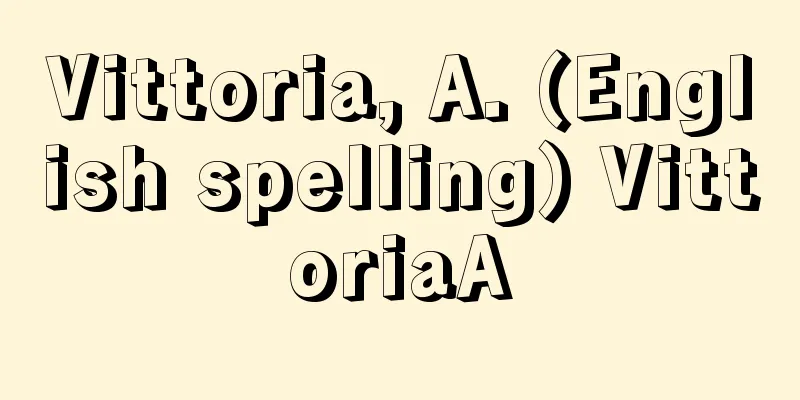Takauji Ashikaga

|
A military commander during the Northern and Southern Courts period. The first Shogun of the Muromachi Shogunate. The second son of Ashikaga Sadauji. His mother was Kiyoko, daughter of Uesugi Yorishige. His first name was Matataro Takauji. In 1319 (Gen'o 1), he was appointed as Jibu no Daibu (Junior Fifth Rank). He married Tomoko, daughter of Hojo Hisatoki. [Kazuhiko Sato] Takauji's vision for governmentIn August 1331 (Ganko 1), when Emperor Godaigo raised an army at Kasagi, he led the Shogunate army to Kyoto together with Osaragi Sadanao. After suppressing the Genko Incident, he returned to Kamakura. In February 1333, when the Emperor escaped from Oki and took refuge at Senjo-san with Nawa Nagatoshi, he again led the Shogunate army to the west, but in Mikawa (Aichi Prefecture), he confided his determination to subjugate the Hojo clan to the elder of his clan, Kira Sadayoshi, and disguised his envoy to Senjo-san, arriving in Tamba, where in April he raised the flag of the restoration of the Genji clan in front of the Shinomura Hachiman shrine. In May, he invaded Kyoto with Akamatsu Norimura and Chigusa Tadaaki, destroyed the Rokuhara Tandai, established a magistrate's office, and brought under his control military commanders from all over the country who had traveled to Kyoto. Upon his return to Kyoto, Emperor Godaigo immediately allowed Takauji to enter the palace, appointed him Shogun of the Chinjufu, and even bestowed him the character "Takaharu" ("the first character of the name"), in praise of his military achievements in the campaign to subjugate the Hojo clan. Although Takauji was given the position of state and shugosho in three provinces, including Musashi, as well as 30 territories, he was dissatisfied with not being appointed Seii Taishogun, and did not participate in any of the organizations of the Kenmu government, but instead strengthened the magistrate's office and began solidifying his own ideas for government. As a result, the animosity between him and Prince Morinaga gradually deepened, and in November 1334 (Kenmu 1), he forced the Emperor to arrest Prince Morinaga and sent him to Kamakura to his younger brother Tadayoshi, who eventually imprisoned him. In June of the following year, 1335, when Hojo Tokiyuki raised an army in Shinano (Nagano Prefecture) and invaded Kamakura, Takauji went east to put down Tokiyuki's rebellion, but again he was not allowed to assume the position of Seii Taishogun. In August, he defeated Tokiyuki's army and recaptured Kamakura, but did not accept Tadayoshi's advice and returned to Kyoto. Instead, in November, he sent a manifesto in Tadayoshi's name to his generals, urging them to gather military forces to exterminate Nitta Yoshisada. Under the pretext of exterminating Yoshisada, he expressed his opposition to the Kenmu government. Emperor Go-Daigo ordered Nitta Yoshisada and Kitabatake Akiie of Mutsu to exterminate Takauji. Takauji defeated Yoshisada's army in the Battle of Hakone Bamboo, and in January 1336 (Engen 1, Kenmu 3), he entered Kyoto and drove the emperor to Mount Hiei. However, he was defeated in a battle with Akiie's army, which entered Kyoto from behind Takauji, and fled to Kyushu. On the way, he announced that he would return the lands that had been confiscated since the Genkō era to calm the unrest of his allied generals, and obtained an imperial edict from the retired Emperor Kogan to avoid the stigma of being an enemy of the Imperial Court. Furthermore, he dispatched powerful generals from his clan, such as the Hosokawa, Imagawa, Kobayakawa, and Ouchi, to various parts of Chugoku and Shikoku to build bases for counterattacks. In March of the same year, Takauji defeated the Kikuchi army at Tatarahama (Higashi Ward, Fukuoka City), and then rapidly recovered his power. In May, he defeated the Kenmu government army led by Kusunoki Masashige at Minatogawa in Hyōgo, and in June, he entered Kyoto and almost completely annihilated the government army in a battle near Kyoto. In August, Takauji, who supported Emperor Komyo, prayed for seclusion, saying, "This world is like a dream," and submitted a handwritten petition to Kiyomizu Temple, asking that Tadayoshi be granted all the blessings of this life. However, the chaotic society of the civil war period could not have led Takauji, the leader of the samurai, to retreat, and his wish remained nothing more than a lifelong dream. In November, Emperor Go-Daigo handed over the sacred treasures to Emperor Komyo, and the following month he fled to Yoshino and founded the Southern Court. During this time, Takauji enacted the "Seventeen Articles of the Kenmu Code," establishing the administrative guidelines of the Muromachi Shogunate. In March 1337 (2nd year of Engen, 4th year of Kenmu), Takauji ordered Takano Moroyasu to capture Kanegasaki Castle in Echizen (Fukui Prefecture). In May of the following year, 1338, Takauji defeated and killed Kitabatake Akiie at Ishizuhama in Sakai, and in July of the leap year, Takauji also killed Nitta Yoshisada, who was regaining power in the northern provinces, in battle at Fujishima in Echizen. In August, Takauji was appointed Shogun, a long-awaited position. It was also in this year that Ankokuji temples and Risho towers began to be built in various provinces to pray for peace and to mourn the souls of those who had died in battle since the Genkō era. In August 1339 (Engen 4, Ryakuo 2), when Takauji learned of Emperor Godaigo's death in Yoshino, he and Tadayoshi held a grand memorial service for the Emperor and also founded Tenryu-ji Temple to pray for his soul. [Kazuhiko Sato] Diarchy: Internal Conflict within the Ashikaga ClanFrom 1347 (Shohei 2, Sadawa 3) to the following year, 1348, a battle unfolded between the Muromachi Shogunate forces and the Southern forces led by Kusunoki Masatsura and others. During this process, the power of Takauji's steward, Takano Moronao, rapidly grew, and the conflict with Tadayoshi, who was highly respected for his role in governing the country, intensified. At Moronao's insistence, Takauji dismissed Tadayoshi, summoned Yoshiakira from Kamakura, and granted Yoshiakira all of Tadayoshi's powers. Tadafuyu, Takauji's illegitimate son and Tadayoshi's adopted son, was also exiled to Kyushu. In October 1350 (Shohei 5, Kan'o 1), Tadayoshi went to Yamato, surrendered to the Southern Court, and raised an army to execute Tadayoshi. In February of the following year, 1351, the power of the Naoyoshi faction overwhelmed the Takauji/Moronao faction, and eventually Moronao and Moroyasu were killed by Uesugi Yoshinori, who was also a member of the Naoyoshi faction. Takauji was angry at the actions of the Naoyoshi faction, and the generals also split into two factions, leading to conflict between them. Thus, the Kanno Disturbance, which began as a conflict between Naoyoshi and Moronao, finally developed into an all-out conflict between the Takauji/Yoshiaki faction and the Tadayoshi/Naofyu faction, and in August, Naoyoshi fled to the northern provinces. Naoyoshi fled from the northern provinces to the Kanto region, but Takauji pursued him with an army to slay him, entering Kamakura in January 1352 (Shohei 7, Bunwa 1), and poisoning him the following month. Takauji spent the next year and a half in Kanto, where he spent his time trying to restore the political situation in the eastern provinces, which had been thrown into chaos by the uprising of Nitta Yoshioki. Takauji returned to Kyoto from Kamakura in September of the following year, 1353. After defeating the attack on Kyoto by Naofuyu's party from January to March of 1355 (Shohei 10, Bunwa 4), Takauji and Yoshiakira's faction finally established their power, and in January of the following year, 1356, Shibata Katsune of Echizen also returned, and the Muromachi shogunate was able to recover from the damage caused by the Kan'o Disturbance. In 1358 (Shohei 13, Enbun 3), Takauji planned an expedition to Kyushu. This was to make a breakthrough in one fell swoop, as the southern army of Prince Kanenaga, supported by the Kikuchi clan, was strengthening its power by invading Hakata and other areas. However, he fell ill and passed away on April 30th of that year at his residence in Nijo-Madano-Koji, Kyoto, before he could accomplish this plan. His posthumous name was Ninzan Myogi. His grave is at Toji-in Temple in Kyoto. [Kazuhiko Sato] PersonalityTakauji's character is always compared to Tadayoshi's, but while Takauji generously gave people gifts of Hassaku oranges, Tadayoshi is said to have disliked the custom of Hassaku oranges and refused to accept them. Muso Soseki praised Takauji as an unprecedented general who possessed the three virtues of courage, compassion, and selflessness. While Takauji was a follower of Soseki and studied Zen, he was also deeply devoted to Jizo faith and Shoden faith. [Kazuhiko Sato] "Ashikaga Takauji" by Yamaji Aizan (1909, Iwanami Shoten)" ▽ "A revised version of Ashikaga Takauji" by Takayanagi Mitsutoshi (1966, Shunjusha)" ▽ "The Disturbances of the Northern and Southern Courts" by Sato Shinichi (1965, Chuokoron-Shinsha)" ▽ "The Civil War of the Northern and Southern Courts" by Sato Kazuhiko (1974, Shogakukan) "Portrait of Ashikaga Takauji, Warrior on Horseback" (traditional copy owned by the Historiographical Institute, University of Tokyo) © Historiographical Institute, University of Tokyo "> Ashikaga Takauji ©Shogakukan "> Ashikaga Takauji's signature Source: Shogakukan Encyclopedia Nipponica About Encyclopedia Nipponica Information | Legend |
|
南北朝時代の武将。室町幕府の初代将軍。足利貞氏(さだうじ)の二男。母は上杉頼重(よりしげ)の女(むすめ)清子(きよこ)。初名又太郎高氏。1319年(元応1)従(じゅ)五位下治部大輔(じぶのだいぶ)。北条久時の女登子と結婚。 [佐藤和彦] 尊氏の政権構想1331年(元弘1)8月、後醍醐(ごだいご)天皇が笠置(かさぎ)で挙兵したとき、大仏貞直(おさらぎさだなお)とともに幕府軍を率いて上洛(じょうらく)。元弘(げんこう)の変を平定後、鎌倉に帰った。1333年2月、天皇が隠岐(おき)を脱出して、名和長年(なわながとし)と船上山(せんじょうさん)にこもるや、幕府軍を率いて再度西上したが、三河(愛知県)で一門の長老吉良(きら)貞義に北条氏討伐の決意を打ち明け、船上山への征途を偽装しつつ丹波(たんば)に至り、4月、篠村八幡(しのむらはちまん)の社前で源氏再興の旗をあげた。5月、赤松則村(のりむら)、千種忠顕(ちぐさただあき)らと京都に侵攻し六波羅探題(ろくはらたんだい)を滅ぼし、奉行所(ぶぎょうしょ)を置いて、全国各地から上洛する武将を傘下に加えた。後醍醐天皇は帰京後ただちに尊氏の昇殿を許し、鎮守府将軍とし、さらに諱(いみな)(尊治)の一字を与えて、北条氏討伐戦における尊氏の戦功を賞揚した。尊氏は、武蔵(むさし)など3か国の国務と守護職、さらに30か所に及ぶ所領を与えられたものの、征夷大将軍に任命されなかったことを不満とし、建武(けんむ)政権のいかなる機関にも参加せず、奉行所を強化し、独自の政権構想を固めつつあった。そのため、護良親王との反目がしだいに深まり、1334年(建武1)11月には、天皇に護良親王の逮捕を強要し、親王の身柄(みがら)を鎌倉の弟直義(ただよし)のもとへ送り、ついに幽閉した。翌1335年6月、北条時行(ときゆき)が信濃(しなの)(長野県)に挙兵し、鎌倉へ侵攻するや、尊氏は時行の乱を鎮圧するため東下したが、このときにも征夷大将軍の地位を許されなかった。8月には、時行軍を撃破して鎌倉を奪回したものの、直義の諫言(かんげん)を受け入れて帰洛せず、11月、逆に、直義の名をもって、新田義貞(にったよしさだ)誅伐(ちゅうばつ)の檄文(げきぶん)を諸将に送って軍勢催促を要請した。義貞誅伐を名目として、建武政権への反意を表明したものである。後醍醐天皇は、新田義貞と陸奥(むつ)の北畠顕家(きたばたけあきいえ)らに尊氏誅伐を命令した。尊氏は箱根竹の下の合戦に義貞軍を破り、1336年(延元1・建武3)1月には入京し、天皇を叡山(えいざん)へと逐(お)った。しかし、尊氏の背後から入京した顕家軍との合戦に敗れ、九州へと敗走した。この途中、味方武将の動揺を鎮めるため、元弘以来の没収地を返付すると発表し、朝敵という汚名を逃れるために、光巌(こうごん)上皇の院宣を獲得した。さらに、一門の細川、今川氏や、小早川(こばやかわ)、大内氏などの有力武将を中国、四国の各地に派遣して、反撃の際の拠点づくりを怠らなかった。同年3月、尊氏は多々良浜(たたらはま)(福岡市東区)で菊池軍を破ったのち、勢力を急速に回復し、5月楠木正成(くすのきまさしげ)を将とする建武政府軍を兵庫湊川(みなとがわ)に破り、6月には入京を果たし、京都近郊の合戦において政府軍をほぼ壊滅させた。8月、光明(こうみょう)天皇を擁立した尊氏は、「この世は、夢のごとくにて候」と、遁世(とんせい)を祈願し、今世の果報を直義に賜りたいとの自筆願文(がんもん)を清水(きよみず)寺に納めたが、混沌(こんとん)とした内乱期社会が、武士の棟梁(とうりょう)としての尊氏を隠遁させるはずもなく、彼の願望は終生を通じての夢でしかありえなかった。11月に、神器を光明天皇に引き渡した後醍醐天皇は、翌月、吉野に逃れて南朝を建てたが、この間尊氏は、「建武式目十七カ条」を制定して、室町幕府の施政方針を確立した。1337年(延元2・建武4)3月、高師泰(こうのもろやす)に越前(えちぜん)(福井県)金ヶ崎城を攻略させた尊氏は、翌1338年5月、北畠顕家を堺(さかい)の石津(いしづ)浜に敗死させ、閏(うるう)7月には、北国で勢力を挽回(ばんかい)しつつあった新田義貞をも越前藤島で戦死させた。そして8月、尊氏は、待望久しかった征夷大将軍に任命された。元弘以来の戦没者の遺霊を弔い、天下の泰平を祈願するために、諸国に安国(あんこく)寺と利生(りしょう)塔を建立し始めたのも、この年のことである。1339年(延元4・暦応2)8月、後醍醐天皇が吉野で死去したことを知った尊氏は、直義とともに天皇のために盛大な法要を営み、さらに天竜寺を創建して、その菩提(ぼだい)を弔っている。 [佐藤和彦] 二頭政治―足利氏の内訌1347年(正平2・貞和3)から翌1348年にかけて、室町幕府軍と楠木正行(まさつら)らを中心とする南軍との攻防戦が展開されたが、この過程において、尊氏の執事(しつじ)高師直(こうのもろなお)の勢力が急速に伸張し、政務を統轄して声望の高かった直義との対立が激化した。尊氏は、師直の強請によって直義を退け、義詮(よしあきら)を鎌倉から呼び寄せて、直義のもっていた諸権限を義詮に与えた。尊氏の庶子で、直義の養子となっていた直冬(ただふゆ)も九州へと逐(お)われた。1350年(正平5・観応1)10月、直義は大和(やまと)に赴き、南朝へ降伏して師直誅伐(ちゅうばつ)の軍をおこした。翌1351年2月には、直義党の勢力は尊氏・師直派を圧倒し、ついに師直・師泰らは直義党の上杉能憲(よしのり)によって殺害された。尊氏は直義党の処置を怒り、諸将も2派に分かれて対立するに至った。こうして、直義と師直との対立抗争に端を発した観応(かんのう)の擾乱(じょうらん)は、ついに尊氏・義詮派と直義・直冬党との全面的な対立へと発展し、8月、直義は北国へと逃走した。直義は北国から関東へと逃れたが、尊氏は直義討伐軍を率いて追撃し、1352年(正平7・文和1)1月には鎌倉へ入り、翌月、直義を毒殺した。尊氏は以後1年有半を関東で過ごすが、それは、新田義興(よしおき)の挙兵によって混乱した東国の政情を回復せんがための日々であった。尊氏が鎌倉より京都に帰ったのは翌1353年9月のことであった。1355年(正平10・文和4)正月から3月にかけての直冬党の京都進攻を退けたのち、尊氏・義詮派はその勢力をようやく確立し、翌1356年1月には越前の斯波高経(しばたかつね)も復帰し、室町幕府は、観応の擾乱による痛手を回復するに至った。1358年(正平13・延文3)尊氏は九州への遠征を計画した。それは、菊池氏に擁立された懐良親王の南軍が、博多(はかた)に攻め入るなどして勢力を強化しつつある情況を一挙に打開せんがためであった。しかし病を得て、この計画を果たすまもなく、この年4月30日、京都二条万里小路(までのこうじ)邸で死去した。法名は仁山妙義。等持院殿。墓所は京都・等持院にある。 [佐藤和彦] 人となり尊氏の人となりは、つねに直義と対比されるが、尊氏が八朔(はっさく)の贈り物を惜しげもなく人々に与えたのに対し、直義は八朔の習俗そのものを嫌い、贈り物を受け取らなかったといわれている。夢窓疎石(むそうそせき)は尊氏を、勇気、慈悲、無欲の三徳を兼備した前代未聞の将軍であったと評価している。尊氏は疎石に帰依して禅を学ぶ一方、地蔵信仰や聖天信仰などにも深く傾倒していた。 [佐藤和彦] 『山路愛山著『足利尊氏』(1909・岩波書店)』▽『高柳光寿著『改稿 足利尊氏』(1966・春秋社)』▽『佐藤進一著『南北朝の動乱』(1965・中央公論社)』▽『佐藤和彦著『南北朝内乱』(1974・小学館)』 「足利尊氏画像 騎馬武者像」(伝) 東京大学史料編纂所所蔵模写(部分)©東京大学史料編纂所"> 足利尊氏 ©Shogakukan"> 足利尊氏花押 出典 小学館 日本大百科全書(ニッポニカ)日本大百科全書(ニッポニカ)について 情報 | 凡例 |
Recommend
anṣāb (English spelling) ansab
...Medina inherited the traditions of the Prophet...
Oil Pass - Oil Pass
...National Route 144 passes through the old Tori...
praktische Rationalisierung (English) praktische Rationalisierung
According to him, before the emergence of rationa...
Canna edulis (English spelling) Cannaedulis
…[Tora Saburo Kawabata]. … *Some of the terminolo...
Wittenwiler, H.
…a Swiss poet of the late Middle Ages. Also known...
Ant wall nageshi - Arikabe nageshi
Around the ceiling edge Spotted and Inside dimensi...
Horse-drawn carriage - basha
A general term for vehicles pulled by horses to t...
lapiés (English spelling)
… Various microtopographies are carved into limes...
Chartres - Chartres (English spelling)
The capital of the Eure-et-Loir department in nor...
Qatar - Qatar
Qatar is an emirate that occupies most of the Qata...
Heusken murder case - Heusken murder case
On the night of December 5, 1861 (January 15, 1861...
Royal Air Force
...The lessons learned from World War I and the a...
Network service
There are two types of network services: "bro...
Swallow Exercise - Enkoushi
A state envoy sent by Korea to Beijing in the Qing...
ANN - ANN
All Nippon News Network is a commercial news netwo...









